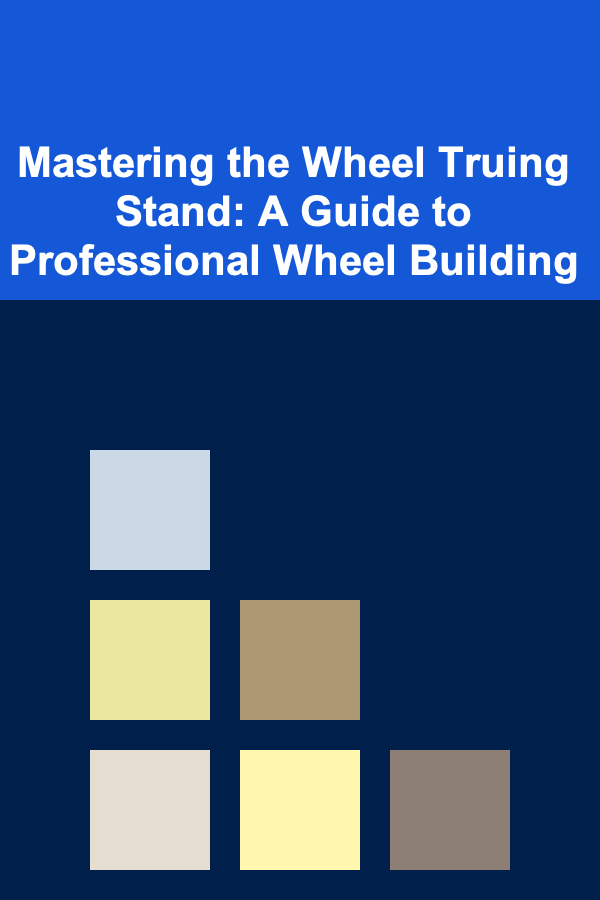
Mastering the Wheel Truing Stand: A Guide to Professional Wheel Building
ebook include PDF & Audio bundle (Micro Guide)
$12.99$10.99
Limited Time Offer! Order within the next:

Building a bicycle wheel is an art and a science. It's a delicate balance of tension, symmetry, and precision. While seemingly simple, a well-built wheel is a testament to the builder's skill and understanding of the forces at play. At the heart of this process lies the wheel truing stand, a tool that transforms a collection of components -- a hub, rim, spokes, and nipples -- into a functional and reliable wheel. This comprehensive guide will delve into the intricacies of using a wheel truing stand, exploring the techniques and nuances that separate amateur wheel building from true professional craftsmanship.
Understanding the Wheel Truing Stand and Its Components
The wheel truing stand is more than just a platform to hold the wheel. It's a precision instrument designed to allow for minute adjustments and accurate measurements. A typical stand comprises several key components, each playing a critical role in the truing process:
- The Base: Provides a stable and solid foundation for the entire stand. A heavier base generally translates to greater stability and reduced vibrations during truing.
- The Uprights: These vertical supports hold the wheel in place. They often feature adjustable arms that accommodate different wheel sizes, from small BMX wheels to larger 29-inch mountain bike wheels.
- The Calipers (Indicators): The most crucial component. Calipers, equipped with adjustable arms and measuring tips (usually with small plastic or rubber tips to avoid scratching the rim), are used to detect lateral (side-to-side) and radial (up-and-down) runout. Some stands utilize dial indicators for precise measurements, while others employ simpler pointer-based systems.
- Hub Mounting Mechanism: This part holds the wheel hub securely. Most stands use a quick-release or a clamping mechanism. Some higher-end stands use thru-axle adapters for modern wheel standards.
Familiarizing yourself with these components is the first step to mastering the wheel truing process. Understand how each part functions and how it contributes to the overall accuracy and stability of the truing stand.
Essential Tools for Wheel Building
Beyond the truing stand, several other tools are essential for successful wheel building:
- Spoke Wrench: This specialized wrench is used to turn the spoke nipples, adjusting spoke tension. It's crucial to use the correct size spoke wrench for your nipples to avoid rounding them off. Multiple sizes may be needed depending on the nipples used.
- Spoke Tension Meter: This tool measures the tension in each spoke, ensuring consistent and balanced tension across the wheel. While experienced wheel builders can develop a feel for spoke tension, a tension meter provides objective measurements and is particularly important for achieving a durable and long-lasting wheel.
- Dish Tool: Used to verify that the rim is centered over the hub. This is known as "dish" and is critical for proper wheel alignment in the frame.
- Nipple Driver: A tool that assists in threading the nipples onto the spokes during the initial stages of wheel building. This saves significant time and effort, especially with wheels that have a high spoke count.
- Lubricant: A small amount of lubricant (e.g., oil or grease) applied to the spoke threads and nipple seat helps to prevent corrosion and facilitates smoother adjustments.
- Spoke Holder (Optional): Can be used to prevent spokes from spinning when tightening nipples.
- Truing Stand Adapter Kit (If Needed): For thru-axle hubs or other non-standard hub configurations, a truing stand adapter kit may be necessary to securely mount the wheel.
Preparing for the Wheel Building Process
Before you even place the hub in the stand, meticulous preparation is key. This includes:
- Component Inspection: Carefully inspect the rim, hub, spokes, and nipples for any defects, damage, or inconsistencies. A faulty component can compromise the entire wheel.
- Spoke Length Calculation: Accurate spoke length calculation is paramount. Incorrect spoke lengths will make building and truing the wheel nearly impossible. Use online spoke length calculators, which require accurate measurements of the hub flange diameter, hub center-to-flange distance, rim effective rim diameter (ERD), and spoke lacing pattern. Double-check your calculations before ordering spokes.
- Spoke Preparation: Apply a small amount of lubricant (spoke prep) to the spoke threads. This will prevent binding and corrosion and allow for easier tension adjustment.
- Rim Tape Installation: Properly install rim tape or a rim strip to protect the inner tube from the spoke nipples. Ensure the tape covers all the spoke holes completely.
Mounting the Wheel in the Truing Stand
Once you have all your components ready, carefully mount the wheel in the truing stand. Follow these steps:
- Adjust the Stand: Adjust the upright arms of the truing stand to accommodate the diameter of your wheel. Make sure the wheel spins freely between the uprights.
- Secure the Hub: Secure the hub in the mounting mechanism of the truing stand. Ensure it is properly centered and tightened to prevent slippage during the truing process. If using a quick-release, tighten it securely. For thru-axle hubs, use the appropriate adapter.
- Spin the Wheel: Spin the wheel to check for any initial runout or wobble. This will give you a starting point for the truing process.
The Truing Process: A Step-by-Step Guide
The truing process involves systematically adjusting spoke tension to correct lateral and radial runout. This is an iterative process that requires patience and attention to detail.
1. Initial Tensioning (Bringing the Wheel to Round)
The initial tensioning stage involves bringing all the spokes to a relatively even and low tension. This is done by turning each nipple the same amount (e.g., two full turns) in a consistent direction. The goal is to create a basic wheel shape that is roughly round and true.
2. Lateral Truing (Side-to-Side Runout)
Lateral truing focuses on eliminating side-to-side wobble. Here's how to do it:
- Identify the High Spot: Spin the wheel and observe the calipers. The area where the rim is closest to the caliper tip indicates a "high spot" (or rather, a spot pulled in one direction).
- Adjust the Spokes: To correct a high spot, you need to tighten the spokes on the opposite side of the rim from the high spot and loosen the spokes on the same side. The amount you tighten or loosen each spoke depends on the severity of the wobble. Start with small adjustments (e.g., a quarter turn).
- Use the "Rule of Opposites": Remember the fundamental principle: Tighten spokes on the side away from the wobble, and loosen spokes on the side of the wobble.
- Work Incrementally: Make small adjustments and then spin the wheel again to observe the effect. Avoid making large, sudden adjustments, as this can easily over-correct the wheel.
- Consider Spoke Pairs: Often, it's best to adjust pairs of spokes rather than individual spokes. This helps to distribute the tension more evenly.
3. Radial Truing (Up-and-Down Runout)
Radial truing focuses on eliminating up-and-down hopping (out-of-roundness). Here's the process:
- Identify the High and Low Spots: Spin the wheel and observe the calipers. The area where the rim is closest to the caliper tip indicates a "high spot" (a bulge). The area farthest from the caliper tip indicates a "low spot" (a dip).
- Adjust the Spokes: To correct a high spot, you need to loosen the spokes connected to that section of the rim. To correct a low spot, you need to tighten the spokes connected to that section of the rim.
- Work Incrementally: As with lateral truing, make small adjustments and observe the effect.
- Adjust Adjacent Spokes: To smooth out the transitions between high and low spots, adjust the spokes adjacent to the main area of adjustment. This helps to create a smoother, more gradual curve.
4. Dish Adjustment (Centering the Rim)
Dish refers to the centering of the rim over the hub. An improperly dished wheel will not sit correctly in the bicycle frame. To check and adjust dish:
- Use a Dish Tool: Place the dish tool on the hub and align the rim indicator with the rim. The tool will have markings or a gauge to indicate whether the rim is centered.
- Adjust Spoke Tension Evenly: If the rim is not centered, you need to adjust the spoke tension on both sides of the wheel. To move the rim towards the left, tighten all the spokes on the left side and loosen all the spokes on the right side by the same amount. Conversely, to move the rim towards the right, tighten all the spokes on the right side and loosen all the spokes on the left side.
- Maintain Overall Tension: When adjusting dish, it's crucial to maintain overall spoke tension. If you tighten the spokes on one side significantly, make sure to compensate by loosening the spokes on the other side.
- Flip the Wheel (Alternative Method): If you don't have a dish tool, you can flip the wheel in the truing stand and check the distance between the rim and the truing stand uprights on both sides. If the distances are unequal, the wheel is not properly dished.
5. Stress Relieving
Stress relieving is a critical step that helps to settle the spokes and prevent the wheel from going out of true over time. This involves applying pressure to sections of the rim to relieve any built-up tension in the spokes and nipples.
- Hand Pressure: Grip the wheel with both hands, placing your thumbs on one section of the rim and your fingers on the opposite side. Apply firm pressure, pushing and pulling the rim in opposite directions.
- Repeat Around the Wheel: Repeat this process around the entire circumference of the wheel, working in small sections.
- Check and Re-True: After stress relieving, re-check the wheel for lateral and radial runout and make any necessary adjustments. The wheel will likely have shifted slightly.
6. Final Tension Check and Adjustment
After stress relieving, use a spoke tension meter to check the tension of each spoke. The goal is to achieve consistent and balanced tension across the wheel. Aim for a tension range specified by the rim and hub manufacturers. If the tension is uneven, make small adjustments to bring all the spokes within the target range. Ensure you are not exceeding the maximum tension ratings for the rim or spokes.
Advanced Techniques and Considerations
Beyond the basic steps outlined above, several advanced techniques and considerations can further improve the quality and durability of your wheels:
- Understanding Spoke Tension Distribution: Spoke tension is not uniform around the wheel. The drive-side spokes on the rear wheel typically require higher tension due to the asymmetrical hub design. Understanding these nuances and adjusting spoke tension accordingly is crucial for optimal wheel performance.
- Dealing with Stubborn Nipples: Sometimes nipples can be difficult to turn due to corrosion or tight threads. Apply a small amount of penetrating oil to the nipple threads and allow it to soak for a few minutes before attempting to turn the nipple. Avoid forcing the nipple, as this can damage the wrench or the nipple itself.
- Troubleshooting Common Problems: Learn to diagnose and address common wheel building problems such as spoke creaking, wheel wobble under load, and broken spokes. These problems often stem from uneven spoke tension, improper dish, or component defects.
- Using a Digital Tension Meter: Digital tension meters offer greater accuracy and consistency compared to analog meters. While more expensive, they are a worthwhile investment for serious wheel builders.
- Building with Different Spoke Patterns: Explore different spoke lacing patterns such as radial, tangential, and combinations thereof. Each pattern has its own strengths and weaknesses in terms of stiffness, compliance, and durability.
- Understanding Rim Brake vs. Disc Brake Considerations: Wheels designed for rim brakes require different spoke tension and rim preparation compared to wheels designed for disc brakes. Pay close attention to these differences when building wheels for specific braking systems.
- Documenting Your Builds: Keep a detailed record of each wheel you build, including the component specifications, spoke lengths, tension values, and any other relevant information. This will help you to learn from your experiences and improve your future builds.
The Importance of Practice and Patience
Building a high-quality wheel is a skill that requires practice and patience. Don't be discouraged if your first few attempts are not perfect. The more wheels you build, the better you will become at understanding the nuances of the process and developing a feel for spoke tension. Take your time, pay attention to detail, and learn from your mistakes. With persistence and dedication, you can master the art of wheel building and create wheels that are strong, durable, and perform exceptionally well.
Conclusion
The wheel truing stand is an indispensable tool for anyone serious about building high-quality bicycle wheels. By understanding its components, mastering the truing process, and practicing diligently, you can transform yourself from a novice into a skilled wheel builder. Remember that precision, patience, and attention to detail are paramount. Whether you're building wheels for yourself or for others, the satisfaction of creating a perfectly trued and tensioned wheel is a reward in itself.

How to Create a Self-Care Routine Checklist for Mental Health
Read More
How to Enhance Your Home Theater with Soundproofing Techniques
Read More
How to Use Digital Tools for Efficient Event Management
Read More
Mastering Efficiency: Strategies for Successful Factory Supervision
Read More
Why Using Color Coding Makes Organization Fun
Read More
Finding Books That Play with Narrative Structure
Read MoreOther Products

How to Create a Self-Care Routine Checklist for Mental Health
Read More
How to Enhance Your Home Theater with Soundproofing Techniques
Read More
How to Use Digital Tools for Efficient Event Management
Read More
Mastering Efficiency: Strategies for Successful Factory Supervision
Read More
Why Using Color Coding Makes Organization Fun
Read More